Running applications from the blockchain on the SAP Cloud Platform
The SAP Cloud Platform is a cloud platform that works on a PaaS or Platform as a Service model. With it, companies can develop their own applications, extensions or add-ons for existing SAP products, or create a hybrid IT landscape in a company using integration between cloud or on-premise solutions.
Last fall, we moved the SAP Cloud Platform to a Russian data center to facilitate the development and use of the platform for domestic customers and users.
In this article we will talk about how to quickly launch an application from the blockchain on the SAP Cloud Platform, as well as a pilot application from the blockchain for pension funds.
')
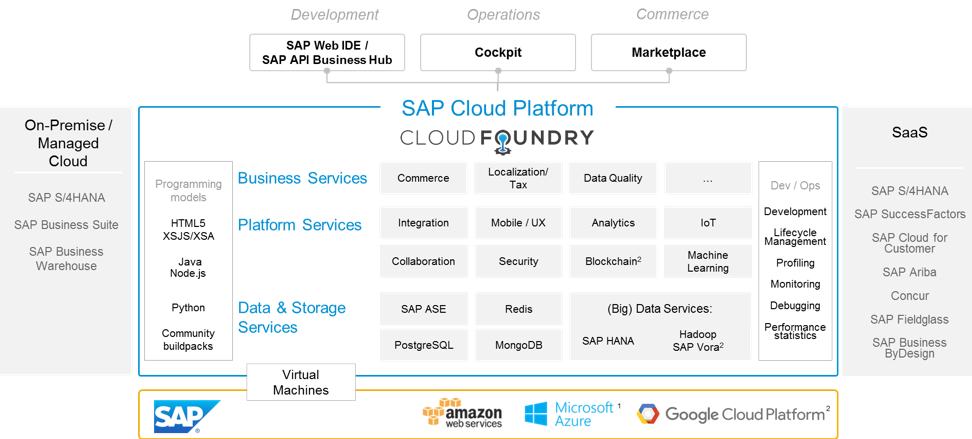
SAP Cloud Platform Architecture
The two main tasks that the SAP Cloud Platform solves are the development and operation of IT solutions (hosting, monitoring, scaling, and more).
Among the services that the SAP Cloud Platform is, there are several categories:
- services for data processing and storage: in-memory, SQL, NoSQL, Big Data Services
- application development services: Java, XS / JS (an internal SAP language for programming under SAP HANA), as well as support for the so-called BYOL model ("bring your own language" - use any programming language, for example, PHP, Python)
- A set of ready-made technology services for creating business applications: blockchain services, integration bus, Internet of things and others
- A set of ready-made business services: shopping cart, loyalty program and others
With the help of ready-made services, companies can quickly develop business applications or purchase ready-made solutions from other companies for further integration.
SAP Cloud Platform Blockchain Services belong in the latter category of ready-made platform services.
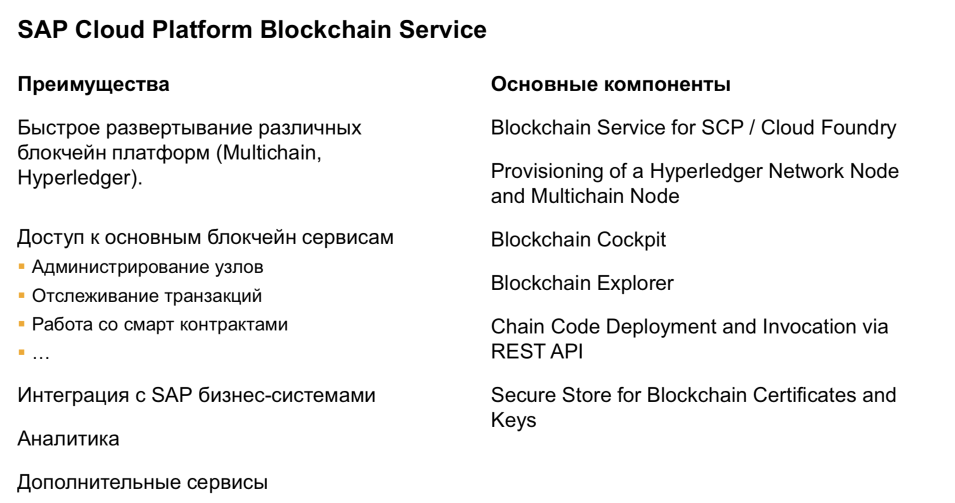
What tasks they solve:
The main components of the SAP Cloud Platform Blockchain Services are:
Below is an example of the architecture of an application made using Hyperledger.

Hyperledger is a platform for the implementation of non-public blockchain networks, access to which participants receive separately.
For example, a participant enters into a consortium that agrees to use a blockchain solution based on Hyperledger. All participants have a complete node that contains a complete copy of the decentralized database. Accordingly, a full node can be hosted on any servers and platforms, including the SAP Cloud Platform. In fact, our client can deploy an additional application on this node that will provide various analytics and operations that ensure the operation of the Hyperledger node.
What SCP Blockchain Services looks like from the inside:
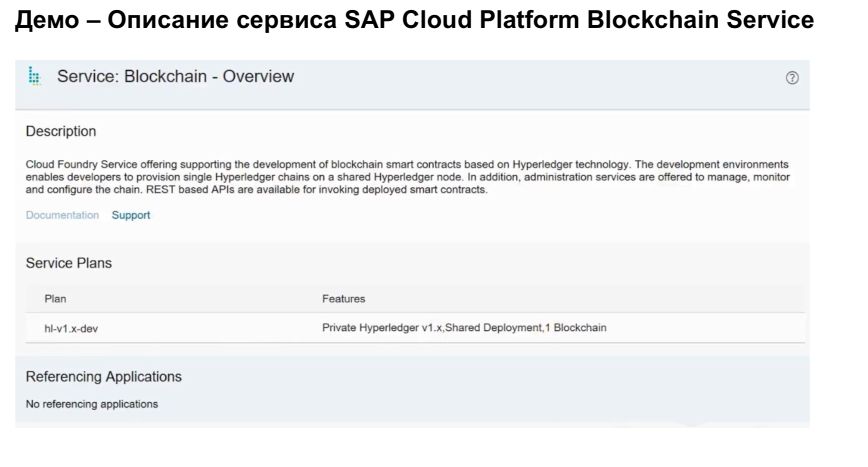
The first screen of the application contains a description of the application, information on the selection of various service plans and reference data on the use of the service.
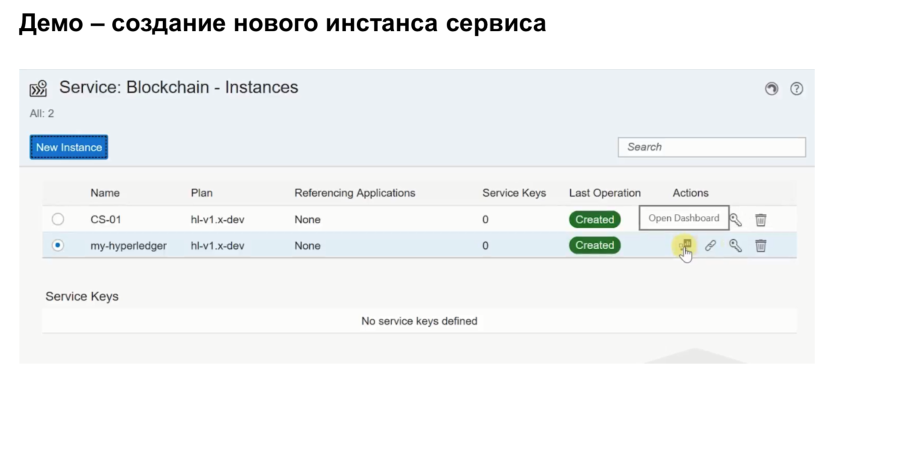
The next screen is the creation of different instances for the service depending on the selected tariff. For each instance there is an interactive panel for management.
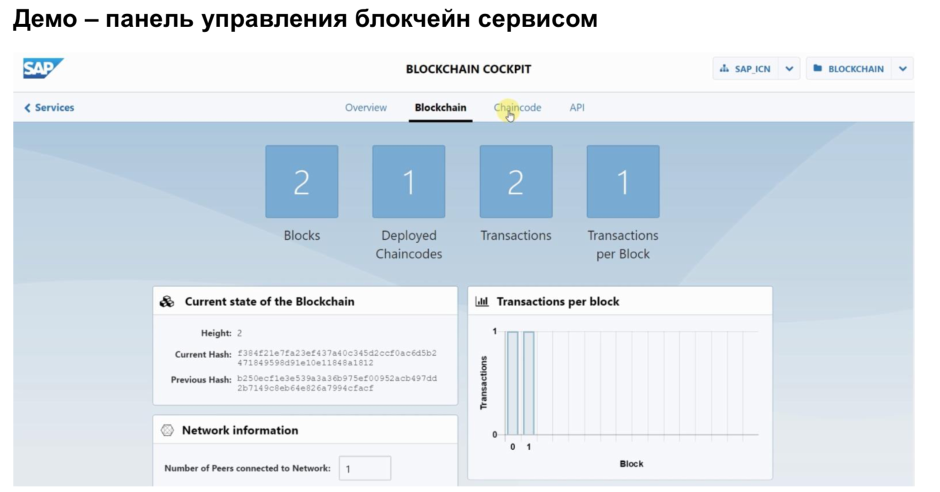
Screen with control panel blockchain service. It contains information about the current status, transactions, blocks and other relevant details.

Smart Contract Screen
With this interface, we can deploy a smart contract in the node Hyperledger, and then test it. There are various methods of working a smart contract - invoke and query. The Invoke method involves changing the blockchain network, in fact, writing a specific transaction to the blockchain. The Query method is a method of reading information, in which we essentially perform a transaction on a specific local node, with no changes throughout the blockchain network.
Creating blockchain applications is not in itself something extraordinary - interesting scenarios begin to appear when we add additional services to the distributed registry. Below in the article we will present one of such examples - the management of individual pension capital.
Blockchain Application Scenario: Managing Individual Pension Capital
SAP has about 30 use cases for blockchain technology in business processes. One of them was invented and implemented as a pilot in Russia - the SAP CIS team and our partners from the developer company Execution.
The pension has several parts - mandatory, voluntary, and also pension capital (in the plans of the government). According to some plans, the part of deductions with mandatory pension capital will be from 0 to 6 percent, the employee will be able to determine this amount independently.
Under the traditional approach, some intermediary will necessarily exist in this scheme - a state pension fund, a state bank, or another organization that is responsible for the centralized registry.
However, there is a problem - the pension fund industry is highly competitive, with fair and unfair competition. This is a classic example of an untrusted environment.
Under these conditions, the idea to build a blockchain network with equal participants to implement this scenario.

The main developer of the script was the company Execution. Together with our colleagues from SAP, they sorted out the business process and tried to isolate those parts that can be solved using the blockchain.
According to the plans of the government, the employee will be able to inform the employer that he plans to pay a certain percentage of his salary to the pension fund. At the same time, he may at any time decide to change this percentage without warning anyone.
In this case, the employer, of course, should receive information about how much he should be deducted to the pension fund - but he should not know exactly which private pension funds go.
Because of this, there is a problem with identification, which can be solved by providing the legal entity with partial access or zero knowledge proof information. The problem is solved through a combination of services, technologies and platforms based on the SAP Cloud Platform.
It is also necessary to identify other participants in this process. Among them:
- banks - must understand to whom and how much to transfer;
- pension funds - they are owners of blockchain nodes and can enter information about the receipts to the account, but they cannot falsify information;
- the person himself - he can at any time transfer the proceeds to another pension fund. He must also have access to information about his savings at any time.
Below we give an example of a pilot system.
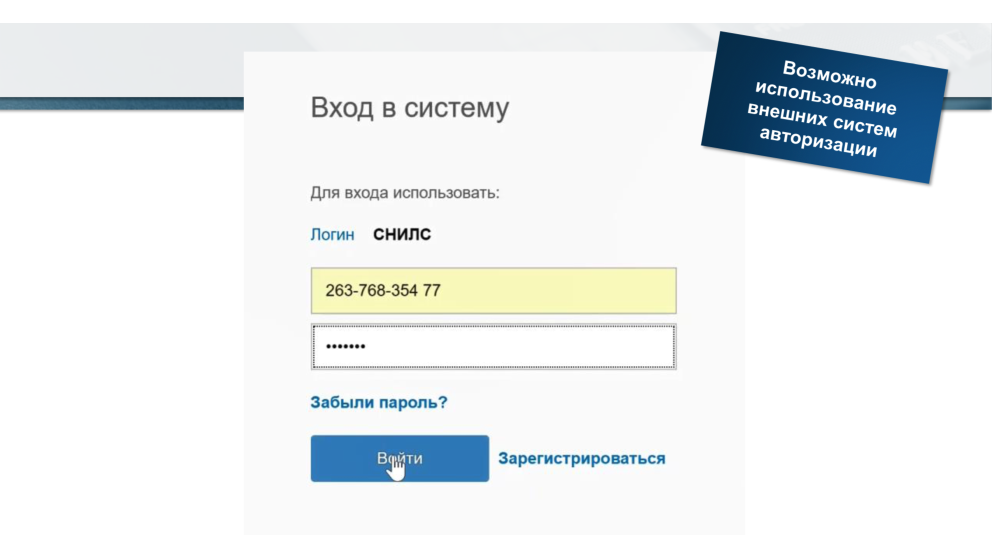
The first screen is user authorization. It is possible to implement authorization using SNILS or state services.
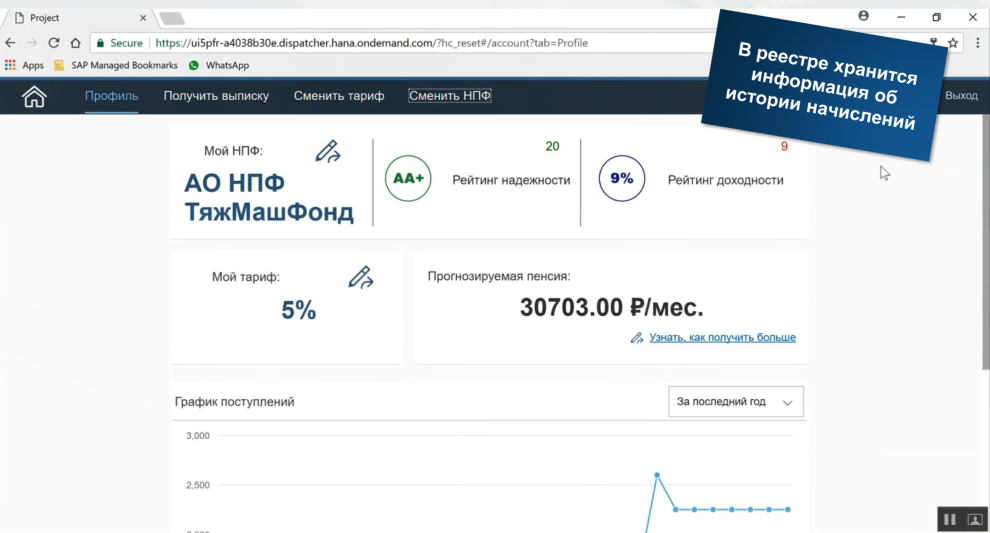
The next screen is a personal account with analytics.
Blockchain technologies are essentially a database, they do not have any additional analytics, graphs and other “decorations”. Therefore, in this pilot, the entire front-end is implemented using the services of the SAP Cloud Platform. This platform includes, among other things, extensive opportunities for integration with external systems, including blockchain networks In this project, the Ethereum network was used as a blockchain.

Transaction Screen
Each charge has its own blockchain-transaction ID and departure ID. Each ID is clickable and contains technical details.
The system also has a luminous status of the transaction. Yellow means that the transaction is in process, green means that it is confirmed by all network nodes (and it is incredibly difficult to change it). As a result, all charges are visible and stored fairly reliably.

Tariff change screen
The user gets the opportunity to change his tariff once during a certain time period. Now for this you need to notify a large number of authorities, which takes about 1 month. In the same system, the tariff changes in one click.

Pension fund change screen
Another example of how to change current processes is a change in the process of changing a pension fund. In the blockchain-based system, this is done instantly - and neither the old APF will delay the documents, nor the new one can postpone the processing of the documents.
Who can be the ultimate client for the implementation of this scenario in practice? Most likely, this is a consortium of non-state pension funds or employers. A single interested party in this system cannot be defined, due to the use of decentralized technologies of the distributed registry.
A little about the development itself. Deploying the blockchain model took only a few days. The main time was taken by the development or addition of the user interface, authorization and analytics systems, the addition of information about pension funds and other details.
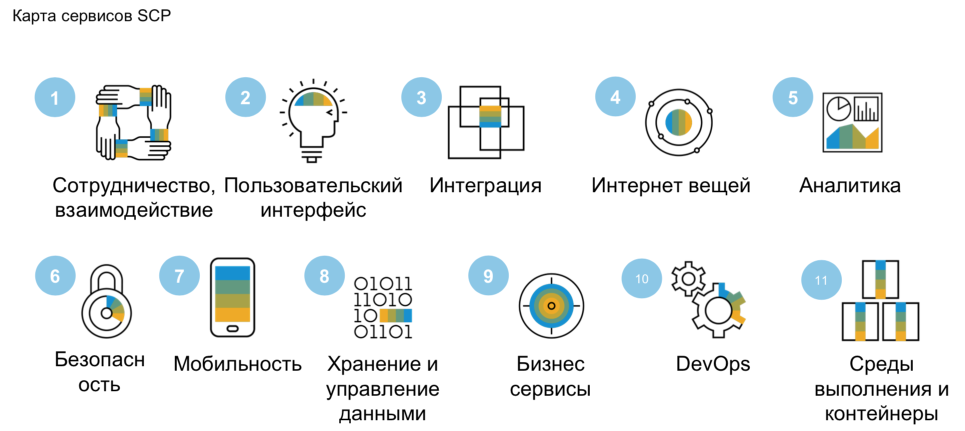
Scheme: what other services can a blockchain application be associated with
It is important to understand that this solution in its current state is only an innovative SAP scenario. In the future, a business case with a business model for calculating how much money is being spent now and how much money can be saved during the transition to a new business process can be drawn up. Our task in developing was to demonstrate the possibility of the technical implementation of this scenario, that it really works. Then everything will depend on the details of the pension reform and the actions of the government.
If you want to test the SAP Cloud Platform yourself, register on the SAP Cloud Platform website.
Last fall, we moved the SAP Cloud Platform to a Russian data center to facilitate the development and use of the platform for domestic customers and users.
In this article we will talk about how to quickly launch an application from the blockchain on the SAP Cloud Platform, as well as a pilot application from the blockchain for pension funds.
')

SAP Cloud Platform Architecture
The two main tasks that the SAP Cloud Platform solves are the development and operation of IT solutions (hosting, monitoring, scaling, and more).
Among the services that the SAP Cloud Platform is, there are several categories:
- services for data processing and storage: in-memory, SQL, NoSQL, Big Data Services
- application development services: Java, XS / JS (an internal SAP language for programming under SAP HANA), as well as support for the so-called BYOL model ("bring your own language" - use any programming language, for example, PHP, Python)
- A set of ready-made technology services for creating business applications: blockchain services, integration bus, Internet of things and others
- A set of ready-made business services: shopping cart, loyalty program and others
With the help of ready-made services, companies can quickly develop business applications or purchase ready-made solutions from other companies for further integration.
SAP Cloud Platform Blockchain Services belong in the latter category of ready-made platform services.

What tasks they solve:
- Rapid deployment of various blockchain technologies based on the SAP Cloud Platform. Now the service available technology Multichain and Hyperledger Fabric. Multichain is a technology that was developed based on the principles of Bitcoin, but is used to create private or corporate blockchain networks.
Hyperledger Fabric is a technology for creating modular blockchain-based networks with access by invitation. Among the features of Hyperledger Fabric - support for smart contracts. - Inside the SAP Cloud Platform, there are also services that make it easier to work with the selected blockchain technology, including services for administering sites, tracking transactions, working with smart contracts, etc.
- Support integration with other SAP business solutions.
- Additional services - analytics, application administration and others.
The main components of the SAP Cloud Platform Blockchain Services are:
- Blockchain Service for SCP (running inside Cloud Foundry)
- Provisioning of Multichain node and Hyperledger Fabric node - for managing nodes
- Blockchain cockpit - blockchain node control panel
- Blockchain explorer - a web application for quick access to information on transactions
- Chain code deployment and invocation via REST API - additional interfaces for quick access to application functions
- Secure store for blockchain certificates and keys - secure storage for certificates and nodes associated with the blockchain
Below is an example of the architecture of an application made using Hyperledger.

Hyperledger is a platform for the implementation of non-public blockchain networks, access to which participants receive separately.
For example, a participant enters into a consortium that agrees to use a blockchain solution based on Hyperledger. All participants have a complete node that contains a complete copy of the decentralized database. Accordingly, a full node can be hosted on any servers and platforms, including the SAP Cloud Platform. In fact, our client can deploy an additional application on this node that will provide various analytics and operations that ensure the operation of the Hyperledger node.
What SCP Blockchain Services looks like from the inside:

The first screen of the application contains a description of the application, information on the selection of various service plans and reference data on the use of the service.

The next screen is the creation of different instances for the service depending on the selected tariff. For each instance there is an interactive panel for management.

Screen with control panel blockchain service. It contains information about the current status, transactions, blocks and other relevant details.

Smart Contract Screen
With this interface, we can deploy a smart contract in the node Hyperledger, and then test it. There are various methods of working a smart contract - invoke and query. The Invoke method involves changing the blockchain network, in fact, writing a specific transaction to the blockchain. The Query method is a method of reading information, in which we essentially perform a transaction on a specific local node, with no changes throughout the blockchain network.
Creating blockchain applications is not in itself something extraordinary - interesting scenarios begin to appear when we add additional services to the distributed registry. Below in the article we will present one of such examples - the management of individual pension capital.
Blockchain Application Scenario: Managing Individual Pension Capital
SAP has about 30 use cases for blockchain technology in business processes. One of them was invented and implemented as a pilot in Russia - the SAP CIS team and our partners from the developer company Execution.
The pension has several parts - mandatory, voluntary, and also pension capital (in the plans of the government). According to some plans, the part of deductions with mandatory pension capital will be from 0 to 6 percent, the employee will be able to determine this amount independently.
Under the traditional approach, some intermediary will necessarily exist in this scheme - a state pension fund, a state bank, or another organization that is responsible for the centralized registry.
However, there is a problem - the pension fund industry is highly competitive, with fair and unfair competition. This is a classic example of an untrusted environment.
Under these conditions, the idea to build a blockchain network with equal participants to implement this scenario.

The main developer of the script was the company Execution. Together with our colleagues from SAP, they sorted out the business process and tried to isolate those parts that can be solved using the blockchain.
According to the plans of the government, the employee will be able to inform the employer that he plans to pay a certain percentage of his salary to the pension fund. At the same time, he may at any time decide to change this percentage without warning anyone.
In this case, the employer, of course, should receive information about how much he should be deducted to the pension fund - but he should not know exactly which private pension funds go.
Because of this, there is a problem with identification, which can be solved by providing the legal entity with partial access or zero knowledge proof information. The problem is solved through a combination of services, technologies and platforms based on the SAP Cloud Platform.
It is also necessary to identify other participants in this process. Among them:
- banks - must understand to whom and how much to transfer;
- pension funds - they are owners of blockchain nodes and can enter information about the receipts to the account, but they cannot falsify information;
- the person himself - he can at any time transfer the proceeds to another pension fund. He must also have access to information about his savings at any time.
Below we give an example of a pilot system.

The first screen is user authorization. It is possible to implement authorization using SNILS or state services.

The next screen is a personal account with analytics.
Blockchain technologies are essentially a database, they do not have any additional analytics, graphs and other “decorations”. Therefore, in this pilot, the entire front-end is implemented using the services of the SAP Cloud Platform. This platform includes, among other things, extensive opportunities for integration with external systems, including blockchain networks In this project, the Ethereum network was used as a blockchain.

Transaction Screen
Each charge has its own blockchain-transaction ID and departure ID. Each ID is clickable and contains technical details.
The system also has a luminous status of the transaction. Yellow means that the transaction is in process, green means that it is confirmed by all network nodes (and it is incredibly difficult to change it). As a result, all charges are visible and stored fairly reliably.

Tariff change screen
The user gets the opportunity to change his tariff once during a certain time period. Now for this you need to notify a large number of authorities, which takes about 1 month. In the same system, the tariff changes in one click.

Pension fund change screen
Another example of how to change current processes is a change in the process of changing a pension fund. In the blockchain-based system, this is done instantly - and neither the old APF will delay the documents, nor the new one can postpone the processing of the documents.
Who can be the ultimate client for the implementation of this scenario in practice? Most likely, this is a consortium of non-state pension funds or employers. A single interested party in this system cannot be defined, due to the use of decentralized technologies of the distributed registry.
A little about the development itself. Deploying the blockchain model took only a few days. The main time was taken by the development or addition of the user interface, authorization and analytics systems, the addition of information about pension funds and other details.

Scheme: what other services can a blockchain application be associated with
It is important to understand that this solution in its current state is only an innovative SAP scenario. In the future, a business case with a business model for calculating how much money is being spent now and how much money can be saved during the transition to a new business process can be drawn up. Our task in developing was to demonstrate the possibility of the technical implementation of this scenario, that it really works. Then everything will depend on the details of the pension reform and the actions of the government.
If you want to test the SAP Cloud Platform yourself, register on the SAP Cloud Platform website.
Source: https://habr.com/ru/post/347556/
All Articles